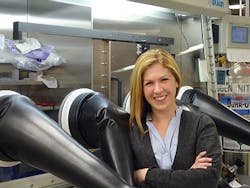Nanoscale alloys emit NIR light for medical applications
Researchers at the University of Pittsburgh (Pittsburgh, PA) have demonstrated that nanometer-scale alloys possess the ability to emit light so bright they could have potential applications in medicine.
âWe demonstrate alloys that are some of the brightest, near-infrared-light-emitting species known to date. They are 100 times brighter than whatâs being used now,â says Jill Millstone, principal investigator of the study and assistant professor of chemistry in Pittâs Kenneth P. Dietrich School of Arts and Sciences. âThink about a particle that will not only help researchers detect cancer sooner but be used to treat the tumor, too.â
Related: Shining near-infrared light on life
In the study, Millstone presents alloys with drastically different properties than beforeâincluding near-infrared (NIR) light emissionâdepending on their size, shape, and surface chemistry. NIR is an important region of the light spectrum and is integral to technology found in science and medical settings, says Millstone. She uses a laser pointer as an example.
âIf you put your finger over a red laser [which is close to the NIR light region of the spectrum], youâll see the red light shine through. However, if you do the same with a green laser [light in the visible region of the spectrum], your finger will completely block it,â says Millstone. âThis example shows how the body can absorb visible light well but doesnât absorb red light as well. That means that using NIR emitters to visualize cells and, ultimately parts of the body, is promising for minimally invasive diagnostics.â
In addition, Millstoneâs demonstration is unique in that she was able to showâfor the first timeâa continuously tunable composition for nanoparticle alloys; this means the ratio of materials can be altered based on need. In traditional metallurgical studies, materials such as steels can be highly tailored toward the application, say, for an airplane wing vs. a cooking pot. However, alloys at the nanoscale follow different rules, says Millstone. Because the nanoparticles are so small, the components often donât stay together and instead quickly separate, like oil and vinegar. In her paper, Millstone describes using small organic molecules to âglueâ an alloy in place, so that the two components stay mixed. This strategy led to the discovery of NIR luminescence and also paves the way for other types of nanoparticle alloys that are useful not only in imaging, but in applications like catalysis for the industrial-scale conversion of fossil fuels into fine chemicals.
Millstone says that taken together these observations provide a new platform to investigate the structural origins of small metal nanoparticlesâ photoluminescence and of alloy formation in general. She believes these studies should lead directly to applications in such areas of national need as health and energy.
The findings have been published in the Journal of the American Chemical Society; for more information, please visit http://pubs.acs.org/doi/abs/10.1021/ja400569u.
-----
Follow us on Twitter, 'like' us on Facebook, and join our group on LinkedIn
Subscribe now to BioOptics World magazine; it's free!
